USF Health group provides care in a forgotten corner of Haiti
Javier Cuevas, PhD, thought he was prepared for the abject poverty he would see in Haiti.
Dr. Cuevas, associate professor of molecular pharmacology and physiology, and a team of other USF and Tampa Bay medical professionals arrived in the small Haitian village of Dilaire in June. It was what they believed to be the village’s first medical mission. Over four days, the team of ten would see more than 1,600 patients, some of whom had rarely, if ever, received medical care.
They treated people with conditions now rare in the United States — untreated eye infections that had turned eyelids swollen and red; horrific fungal infections spread across the scalp; and wounds that had festered and turned septic after weeks without medical treatment.

But it was what happened when it rained that showed Dr. Cuevas how desperate Haiti’s circumstances truly are.
“We had a huge rainstorm, and there was a ditch in the side of the road,” he said. “People were jumping into it to bathe. There’s nothing here that compares to that poverty level. I could not believe the poverty level people were living in.”
Even Dr. Steve Morris, another member of the USF group, found himself shocked although he has provided medical aid after disasters around the world, from Thailand to Myanmar.
“The poverty there is astounding,” said Dr. Morris, MD, RN, an assistant professor and project director for bioterrorism and disaster training in the College of Nursing.
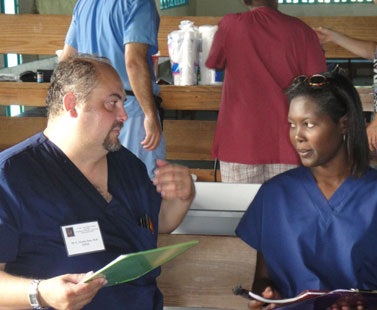
It was that poverty that originally inspired the USF group to plan the trip to Dilaire, not the January earthquake that devastated the island nation. Faculty members had planned to take a group of students. After the earthquake, it was determined that the students’ safety could not be assured. But the other faculty and staff members decided to make the trip anyway.
In addition to Dr. Cuevas and Dr. Morris, other USF health care providers making the trip were Glenn Whelan, PharmD, an assistant professor and pharmacist in the College of Medicine; Sandy Lesieur, RN, operating room nurse at the Morsani Center for Advanced Healthcare; and Dr. Edgardo Nicolas Toro, clinical assistant professor and an internist at James A. Haley Veterans’ Hospital.
The group also received an outpouring of money, supplies and other help from other USF colleagues, Tampa Bay community groups and Haiti aid organizations.
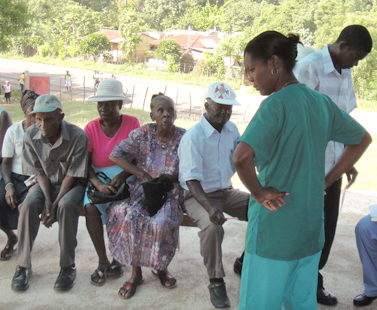
The group chose Dilaire, a village of 4,000 in the northeast corner of Haiti, for its medical mission because Corpus Christi Catholic Church, where Dr. Cuevas is a member, already traveled there for church missions. Although the USF trip was, of course, not a religious mission, those ties did provide contacts for the logistical help needed to set up a sizable temporary clinic. The group was able to set up its clinic in a Dilaire church, and group members who traveled there stayed at the home of a local priest.
Dr. Morris treated one woman who moved to Dilaire after her entire family — husband, children and extended family — was killed in the earthquake.
“Her story brought tears to my eyes,” Dr. Morris said.
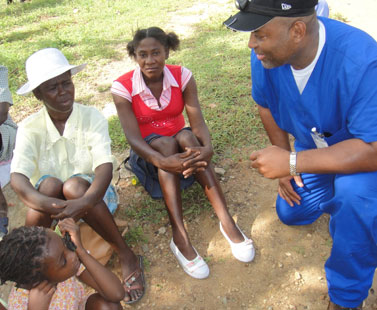
Most of the patients suffered from chronic poor health, compounded by a lifetime of poverty and failure to receive medical care. Over 1,000 such people had moved into the small town of Dilaire after the earthquake, further stressing the area’s infrastructure.
The doctors saw terrible cases of chronic infections. Bleary red eyes and fluid-filled ears. Every kind of cellulitis they could imagine. UTIs and vaginitis.
Glaucoma, blindness. Severe asthma. Minor surgical procedures. Infected, ingrown toenails that had to be removed.

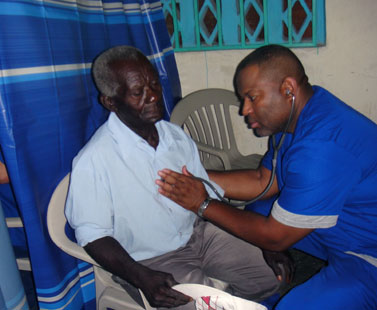
They treated tropical diseases that are rare here, such as malaria and elephantiasis. They arranged for a girl with a cleft palate to be brought to the United States for surgery.
Hypertension is commonplace in Haiti, and they saw it with stunning frequency.
“I had three patients in a row with systolic pressures over 200 and diastolic pressures over 160,” said Dr. Cuevas.
At first, he thought his equipment must be broken, but another blood pressure cuff confirmed his findings of three consecutive patients in hypertensive crisis.

The medical team found one bright spot in the high infection rate.
Because most of the patients had never received treatment, they responded incredibly rapidly to antibiotics. One man came in with a cut from a machete, so deep it had exposed the bones of his hand. The injury was days, perhaps weeks old, and the infection was already so bad that in this country doctors would most likely have chosen to amputate the hand.
“We had no choice but to give him high doses of antibiotics,” said Dr. Morris. “Fortunately, one of our donations was a complete set of IV antibiotics, along with the complete intravenous set-ups.”
When the man returned the next day for a follow-up visit, they were delighted, if surprised, to see that the infection had begun to improve.
Another man came in with pneumonia, already so weak that his family members had to carry him into the clinic.
“If they hadn’t been able to get this gentleman into a truck to come here, he would have died,” Dr. Cuevas said.
But with antibiotics, he made a remarkable recovery. He was able to walk out of the clinic himself.
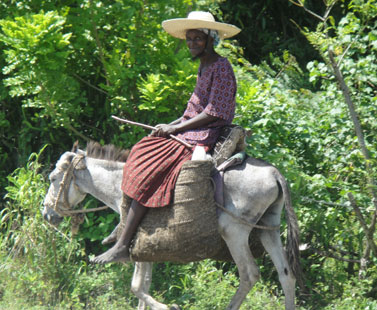
Operating the clinic required improvisation and battlefield-style logistical maneuvers. Each night, the clinic’s pharmacy was dismantled, the drugs tallied and taken to the house where the group stayed. Each morning, the pharmacy had to be put together again.
Pharmacists filled some 500 prescriptions a day. Some patients needed three or four drugs; the pharmacists had to find substitutes as they ran out of more common medicines.
Patients signed up to visit with little notice, and sometimes accompanying family members turned out to need medical attention as well.
The team sometimes had to confront grim realities. Not every patient could be helped, not everyone successfully treated. One man came in with a perforated bowel. “Here, he would have been in the O.R. in five minutes,” Dr. Morris said.
But there, they didn’t have surgical facilities. They treated him as best they could and arranged for transportation to the nearest hospital — an hour-long journey in a truck over Haiti’s notoriously bad roads.
They soon heard the man had died within an hour of arriving at the hospital.
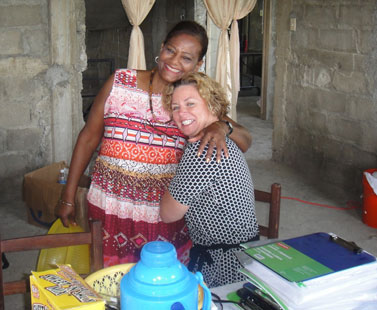
Faculty members believe USF medical, nursing, public health and pharmacy students could learn much by trying to cope under such circumstances, and seeing patients with new conditions.
“That’s another reason it would be great for students,” Dr. Morris said. “You don’t see those diseases anymore.”
Students would learn in other ways as well.
“Because you don’t have a million fancy tests, it’s medicine at its most basic,” Dr. Cuevas said. “You have to really practice the art of medicine and nursing.”

The group hopes to make the mission to Dilaire an annual event. They even discuss going twice a year, often enough, Dr. Morris pointed out, to provide regular preventive health care for Dilaire’s residents.
“I know that, even in the few days we were there, we saved some lives,” Dr. Cuevas said.
They see a value to going to this remote corner of Haiti last month, with the world’s attention, once riveted on the relatively distant Port-au-Prince, now beginning to fade.
Once the TV cameras and the outpouring of aid are gone, Dilaire will still need help.
“The definition of a disaster is that the need is greater than the resources available,” Dr. Morris said. “Haiti is a textbook example. We couldn’t fix everybody. But we did a lot in that clinic.”
-Story by Lisa Greene, USF Health Communications; photos courtesy of Dr. Steve Morris
Those who provided other aid and assistance to the medical mission included:
Corpus Christi Catholic Church, which raised more than $30,000; the USF Latin American Medical Student Association; Dr. Stephen Klasko, dean of the USF College of Medicine; Project World Health; Dr. Eddy Gonzalez; Dr. Richard Roetzheim; Dr. Lucy Guerra; Dr. Mike Kovac, dean emeritus of USF Engineering; Patricia Eddy of Help Brings Hope for Haiti; Mike McCormick, director of pharmacy, James A. Haley Veterans’ Hospital; Father Janvier Joseph of St. Michael the Archangel parish in Dilaire, Haiti.

